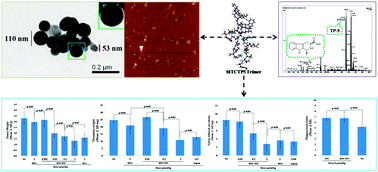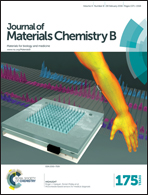Tetrahydro-β-carboline-3-carboxyl-thymopentin: a nano-conjugate for releasing pharmacophores to treat tumor and complications†
Abstract
To improve the therapeutic efficacy of cancer patients a novel conjugate of thymopentin (TP5) and (1S,3S)-1-methyl-tetrahydro-β-carboline-3-carboxylic acid (MTC) was presented. In water and mouse plasma MTCTP5 forms the nanoparticles of 14–139 nm in diameter, the suitable size for delivery in blood circulation. In mouse plasma MTCTP5 releases MTC, while in the presence of trypsin MTCTP5 releases MTC and TP5. On mouse and rat models the MTCTP5 dose dependently slows down the tumor growth, inhibits inflammatory response and blocks thrombosis. The anti-tumor activity as well as the anti-inflammation activity and anti-thrombotic activity of MTCTP5 are 100 fold and 10 fold higher than those of MTC, respectively, which are attributed to the fact that it down-regulates the plasma levels of TNF-α and IL-8 of the treated animals. The immunology enhancing activities in vitro and in vivo of MTCTP5 are similar to those of TP5, which is attributed to the fact that MTCTP5 up-regulates the plasma levels of IL-2 and CD4 as well as down-regulates the plasma level of CD8 of the treated animals. The plasma alanine transaminase, aspartate transaminase and creatinine assays indicate that MTCTP5 therapy does not injure the liver and the kidney of the animals. The survival time of MTCTP5 treated mice is significantly longer than that of TP5 treated mice.


 Please wait while we load your content...
Please wait while we load your content...